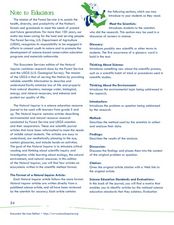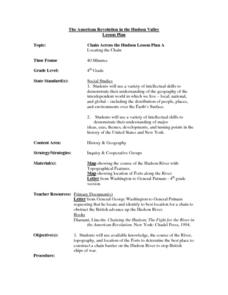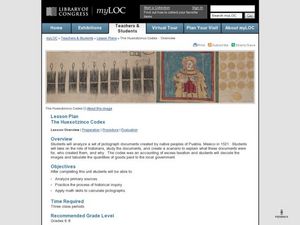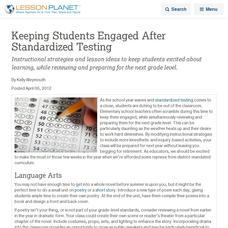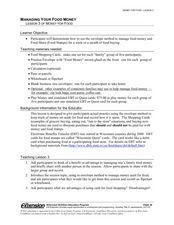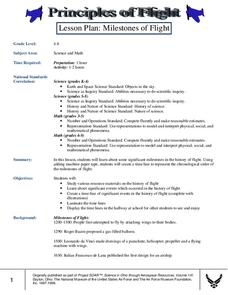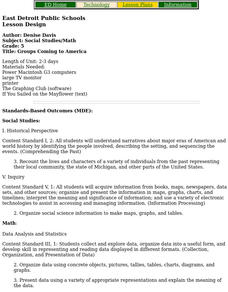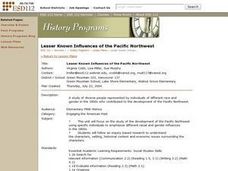Curated OER
Natural Inquirer Ecosystem Article Lesson
Young scholars discover new ways to preserve the ecosystem by completing graphic organizers. In this environmental lesson, students read an article from the Natural Inquirer in small groups and fill out a graphic organizer based on...
Curated OER
Coal Supply and Demand
A hands-on simulation perfect for an economics instructional activity, young learners investigate the availability of different sources of natural energy (coal, natural gas, oil, solar, and nuclear) and how this availability affects...
Curated OER
Is the Hudson River Too Salty to Drink?
Students explore reasons for varied salinity in bodies of water. In this geographical inquiry lesson plan, students use a variety of visual and written information including maps, data tables, and graphs, to form a hypothesis as to why...
Curated OER
Chain Across the Hudson Lesson Plan A - Locating the Chain
Learners read a letter from George Washington requesting them to identify on a map a location that would stop the advance of British warships. They choose a location and justify their choice.
Curated OER
Charts, Maps, and Graphs Lesson on the Holocaust
Students practice interpreting data. In this Holocaust lesson, students research selected Internet sources and examine charts, maps, and graphs regarding the Jewish populations in and out of Europe. Students respond to questions about...
Albert Shanker Institute
Economic Causes of the March on Washington
Money can't buy happiness, but it can put food on the table and pay the bills. The first of a five-lesson plan unit teaches pupils about the unemployment rate in 1963 and its relationship with the March on Washington. They learn how to...
Visa
In Trouble
What are some of the financial risks associated with using credit? Pupils learn the warning signs of incurring financial hardship, and through PowerPoint presentations, worksheets, and discussion, discover the...
Curated OER
Lesson PlanThe Huexotzinco Codex
Students examine primary sources that include pictographs from Puebla, Mexico. In this Huexotzinco Codex lesson, students perform historical analysis as they investigate the codex as they make inferences and draw conclusions about taxes...
Curated OER
Caring for a Pet
Students identify the responsibilities of pet owners. In this animal welfare lesson, students read the book Animals As Friends and list the characteristics of a good pet owner. Students use a tally sheet to determine what pets students...
PBS
The History and Use of Sampling Methods
Young mathematicians define population, draw convenience sample from the population, draw quota sample from the population, and draw random probability sample from the population. They explain why a random probability sample usually...
Curated OER
History Detective: The Case of the Mysterious Trunk
Students role play as history detectives. In this historical inquiry lesson, students discuss what detectives do, analyze a trunk of "artifacts" and make conclusions about its fictional owner. Students complete six pages of related art,...
Curated OER
Keeping students engaged after standardized testing
Instructional strategies and lesson ideas to keep students excited about learning, while reviewing and preparing for the next grade level.
EngageNY
TASC Transition Curriculum: Workshop 15
What do a cheetah, Audi commercial, and air have in common? They're all topics of an engaging inquiry-based, hands-on workshop for educators about background knowledge, reading strategies, the CER model, and argumentative writing. The...
Curated OER
Managing Your Food Money
Students investigate family budgeting methods. In this family budget lesson, students examine the wages and expenditures of family and participate in a simulation that requires them to employ the envelope budget method.
Curated OER
Hachimaki/Shibori Lesson Plan
Sixth graders are introduced to the technique of Arashi Shibori and its history. In groups, they discover how to perform this process and examine how to do hachimaki. To end the lesson, they make their own hachimaki to wear and share it...
Curated OER
What did I find?
Students excavate an artifact. In this archaeology lesson, students get a bucket filled with dirt and a broken up artifact. They work in groups to take it out and to find what its purpose was.
New York City Department of Education
Egypt
This six-week unit encompasses all subjects with a focus study on world history and the development of ancient civilizations. As gifted and talented students dive into the interesting yet challenging topic of Egypt, they...
Curated OER
Milestones of Flight
Students identify significant milestones in the history of flight. For this aviation history lesson, students study various resource materials and construct timelines of significant achievements.
Curated OER
Striking It Rich!
Fifth graders explore the California Gold Rush. They explore the lure of gold and the Wild West, how pioneers traveled to the West, and the hardships and people they encountered along the way. Activities be authentic, hands-on, and...
Curated OER
Gender Disparity on Display
Students explore an article and discuss what gender differences. In this exploring gender lesson plan students divide into groups and develop a social theory.
Curated OER
Primary Sources and Archaeology in the Study of Ancient Mediterranean Trade
Tenth graders begin the lesson by plotting trade routes, major empires and items traded. Using primary sources, they examine their own values regarding trading items for royality. They participate in a role-play exercise in which they...
Curated OER
Tropical Atlantic Aerosols
Students analyze NASA data from the Multi-angle Imaging Spectroradiometer. In this NASA data lesson, students access an assigned website to examine information from the MISR on the Terra Satellite. They determine how desert dust travels...
Curated OER
Groups Coming to America
Fifth graders use text or other references to locate different types of information about the Mayflower and pilgrims. They create a presentation for lower elementary classes about the Pilgrims.
Curated OER
Lesser Known Influences of the Pacific Northwest
Students engage in research about the development of the Pacific Northwest using specific individuals to emphasize different racial and gender influences in the 1800's. The research method that is used is inquiry based.
